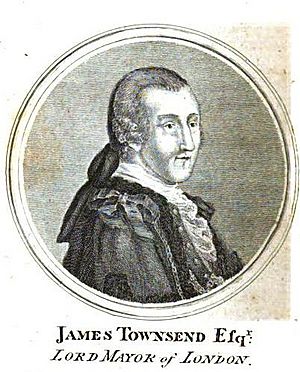James Townsend (British politician) facts for kids
James Townsend (baptised 8 February 1737 – 1 July 1787) was an important English politician. He was a member of the Whig political party. He became the Lord Mayor of London from 1772 to 1773. Many people believe he was the first black Member of Parliament (MP) in England. He is also thought to be the first black Lord Mayor of London.
James Townsend's Political Journey
James Townsend was born in London in 1737. He was baptised on February 8, 1737. His father, Chauncy Townsend, was a merchant and also an MP. James went to Hertford College, Oxford in 1756.
In the 1760s, James Townsend became close to a powerful Whig leader. This was William Petty, 2nd Earl of Shelburne. With Shelburne's help, Townsend became a Member of Parliament (MP) for West Looe in 1767. He held this position until 1774.
In 1769, Townsend was chosen as an Alderman for Bishopsgate in London. He also became a Sheriff of the City of London. This made him one of the main leaders of the Whig party in London. Townsend was one of the people who started the Society of Gentlemen Supporters of the Bill of Rights. This group supported John Wilkes, another politician. However, Townsend later disagreed with Wilkes and became one of his strongest opponents.
Townsend was elected Lord Mayor of London in 1772. Another politician, John Wilkes, had received more votes. But the Sheriff, Richard Oliver, changed the voting process. This was done to stop Wilkes from winning. This caused a lot of trouble in London. A crowd of people, angry about Townsend's election, protested outside Guildhall. Townsend's family symbol was even removed from a church. John Wilkes later became Lord Mayor in 1774.
In 1781, Townsend supported calls for changes to how elections were run. He ran for Parliament again in 1780 but did not win. In 1782, Shelburne helped Townsend get elected to Parliament for Calne. As an MP, he supported some reforms. He mostly supported William Pitt the Younger. Townsend died on July 1, 1787, while still in office. He passed away at his home, Bruce Castle in Tottenham. He was buried nearby in his wife's family tomb. His wife's inheritance had made him a very rich man.
Townsend's Family History
James Townsend's mother was Bridget. She married Chauncy Townsend in 1730. Bridget's father was James Phipps. He came from a well-known family in Westbury.
When he was sixteen, James Phipps started working for the Royal African Company (RAC). This company traded enslaved people across the Atlantic Ocean. Phipps lived in Africa for twenty years. He died at Cape Coast Castle in 1723. This castle was the main base for the RAC in Africa. He became the highest-ranking RAC official in Africa.
At Cape Coast, James Phipps married Catherine. She was the daughter of an African woman and a European soldier. Catherine Phipps was left a lot of money in her husband's will. However, she chose to stay in Africa and died there in 1738. James and Catherine had several children, including James Townsend's mother, Bridget. All their children were of mixed race. Because of this, James Townsend is believed to be Britain's first black Member of Parliament. He is also thought to be the first black Lord Mayor of London. It seems that this part of his family history was not widely known at the time.
In 1763, James Townsend married Henrietta Rosa Peregrina du Plessis. She was the daughter of Henry Hare, 3rd Baron Coleraine. Henrietta Rosa was supposed to inherit her father's property. But because she was not a British citizen, the property went to the Crown. With his father's help, Townsend managed to get the property back. This was done through a special law passed by Parliament. Bruce Castle, Townsend's home in Tottenham, was part of his wife's inheritance. He made changes to parts of the building.
James and Henrietta had one son, Henry Hare, and one daughter, Henrietta Jemima. Henry Hare Townsend (1766–1827) married Charlotte Winter Lake. Their son was the poet and writer Chauncy Hare Townshend. The famous writer Charles Dickens dedicated his book Great Expectations to him. Henrietta Jemima Townsend (1764–1848) married Nicholas Owen Smythe Owen. They did not have any children.
James Townsend's brother was Joseph Townsend. He was a doctor, scientist, and economist. He made important contributions to studies about population and geology.
Images for kids





